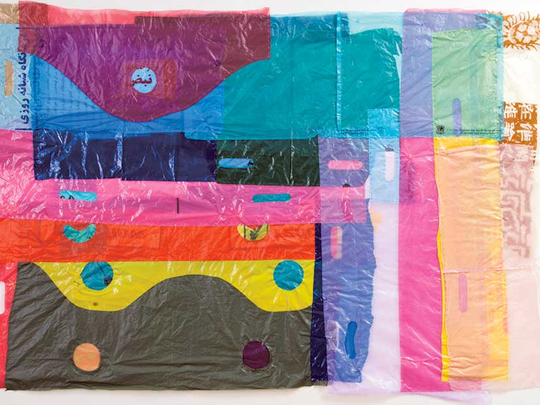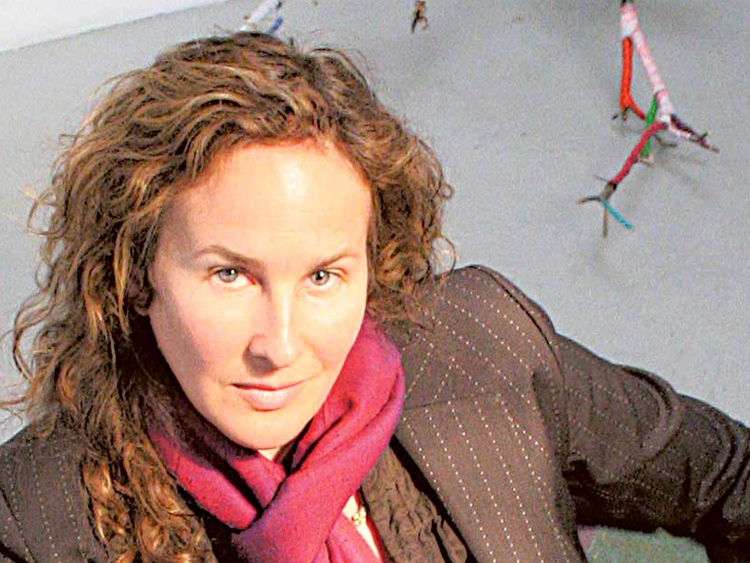
As she progressed from flat collage pieces to create two- and three-dimensional art pieces, large-scale sculptures and installations, American artist Dianna Cohen turned her attention to the ubiquitous plastic shopping bag — the single most outstanding representative of contemporary First World culture.
“Plastic bags come in a rainbow of colours, have artful typography and images on them,” says Cohen, who was inspired to use them as source material for her artwork more than 25 years ago.
A student of biology and painting at the University of Southern California, Cohen initially worked with watercolours and oil paint. She then explored collage using brown paper bags from the market, which held her interest for a couple of years. “At some point I added a piece of a plastic bag from a homoeopathic pharmacy in Belgium which had an image of a plant printed on it with its Latin name below. I found a deep irony in the idea of printing plants and images from the natural world on to synthetic plastic bags made from petroleum,” says Cohen. “I realised that plastic is such a loaded material. It represents the future and man’s harnessing of technology. They come in every colour and at heart I am a Fauvist; so I began to explore plastic bags as a medium.”
Thus it was that she sourced materials most people consider trash, such as bottle caps, little pieces of plastic and boxes. But this was not the first time Cohen had become aware of plastic, a material so abundant in our lives that we often pay scant attention to its presence.
As an avid water lover, eternally aspiring longboarder, snorkeller, diver, swimmer and bodysurfer, she had begun to notice more and more plastic in the ocean and sea over the years. “Then I heard about the Great Pacific Garbage Patch and became aware of the plastic pollution situation,” she says. “As I was working with plastic bags and was interested in the geometry and juxtaposition of the found images and text on them, I shifted my intention in the art pieces to convey specific messages and make statements.”
Examples include “No War Please” and “Postconsumer Mandala”, collages made entirely of plastic shopping bags.
However, after around eight years of working with plastic for her artwork, some of the bags began to fissure and break apart. “Initially I believed that the bags were ephemeral like plants and animals and us. I realised that due to their chemical makeup, only some of the bags break apart, and I decided to embrace this as a part of the piece. In a sense, I believed, they are alive and will transform.”
Cohen soon learnt that plastic is forever; that it cannot biodegrade and that even if it breaks down into tiny bits, it still exists, ending up in oceans and killing marine life. It was around this time that she began to make personal changes in her life, ditching the plastic bag for reusable canvas bags while shopping and carrying metal flasks and bamboo cutlery in her handbag in lieu of disposables.
Cohen recollects that she was so angry on learning about the Great Pacific Garbage Patch that “my first reaction was to go out there and clean this thing up. I created a proposal to do just that, but upon further reflection I realised I needed to back up and look at the bigger picture, and this led me to realise that source reduction is key.”
Increasing awareness of plastic’s potential to pollute the natural world drove Cohen to co-found the Plastic Pollution Coalition in 2009 with like-minded individuals, businesses, policymakers and organisations. “PPC was formed as a platform to amplify a common message through strategic planning and communication,” she says. “Today, we have grown to a global coalition of more than 500 NGOs and businesses around the world working to stop plastic pollution and to measurably reduce it.”
The goal is to break the cycle of plastic use, mainly single-use and disposable plastics, she says, especially as the intrinsic nature of plastic is such that it can go from being appealing or convenient to becoming trash in just a few seconds. “I have a big problem with single-use and disposable plastic. Plastic is primarily made out of petroleum. The idea that packaging or items have specifically been designed with intended obsolescence is a very irresponsible use of a valuable material. So at this point, I have a love/hate relationship with my chosen material.”
One of the main issues the PPC seeks to highlight about the nature of plastics is that they are not designed for closed-loop recycling. It is a myth that disposable plastics are sustainable because they are recycled, says Cohen. “Many disposable plastic products such as disposable razors cannot be recycled because they are made of combined materials, such as plastic and metal. Waste to energy will certainly not solve the problem, but will only create more particulate pollution.”
Plastic recycling rates in the US are very low, she adds. According to a 2015 US EPA report, plastics recycling rate, at 8.8 per cent in 2012, rose to 9.2 per cent during 2014.
“I am more concerned with plastic and the chemicals that leech from it and how they impact human and animal health. My personal preference is to choose alternatives to plastic packaging whenever possible. Recycling very often is actually just downcycling,” she says.
Two broad classes of plastic-related chemicals that are of critical concern for human health are bisphenol-A or BPA, and additives used in the synthesis of plastics, which are known as phthalates, according to a study by the Arizona State University. Other studies have also shown that plastic threatens wildlife as more than 260 species, including invertebrates, turtles, fish, seabirds and mammals, have been reported to ingest or become entangled in plastic debris, resulting in impaired movement, lacerations and death.
With Cohen’s passion for the marine environment, she is also helping to raise awareness of the presence of non-degradable plastics that are clogging our oceans. “Plastic pollution in the ocean and the Great Pacific Garbage Patch have provided an entry point to begin to understand the global impact of the plastic pollution crisis. Plastic pollution knows no boundaries. It is everyone’s problem, it is everyone’s fault.”
According to a new Ellen MacArthur Foundation report launched at the World Economic Forum earlier this year, “there will be more waste plastic in the sea than fish by 2050”. The report explains that every year “at least eight million tonnes of plastics leak into the ocean — which is equivalent to dumping the contents of one garbage truck into the ocean every minute”.
Citing a 2014 “PLoS One” report, Cohen says that more than five trillion plastic pieces, weighing more than 250,000 tonnes, are afloat at sea and that the toxic chemicals released by plastic poisons the food chain.
In an attempt to provide everyday strategies to cut down the amount of plastic we use and throw away, the PPC added a fourth “R” to the traditional three “Rs” of the environment — Reduce, Reuse and Recycle. “PPC launched the Refuse campaign where we took the original “3R” model and added a fourth “R” on to the front, Refuse,” says Cohen. “Whenever possible, I believe we should refuse disposable plastic and request non-plastic alternatives. Embracing this habit empowers individuals, schools, businesses, NGOs and governments to measurably reduce their plastic footprint.”
With the UAE having one of the highest rates of bottled water consumption in the world — each individual reportedly consumes an average of 250 litres of bottled water a year — Cohen advises that everyone should ask themselves: what is my access to clean drinking water?
“In the US in the 1980s, plastic bottle water began to be sold to us through expensive marketing campaigns, which made one feel that they were drinking pure glacial water, but in reality that was the beginning of shifting public attention away from municipal water sources,” she says. “Because plastic is made with chemicals such as phthalates and bisphenols, which are known endocrine disrupting chemicals, we would all be wise to look for healthier packaging and delivery systems for our water. Think glass and steel and ceramic and filtered tap water at home.”
As an advocate of choosing alternatives to single-use plastics, Cohen says that everyone can make a difference to address the menace of plastic by making simple changes in their choices. “Refuse single-use plastic daily,” she says. “Easy ways to get started include bringing your own [preferably non-plastic] reusable water bottle, coffee cup, straw, utensils, lunch box, and bags. Put very little in the recycling bin, and buy products in minimal packaging as possible — that is the best solution to the plastic pollution problem.”
Sangeetha Swaroop is a writer based in Dubai.













